AMD FX-8320E CPU Review: The Other 95W Vishera
by Ian Cutress on January 13, 2015 10:00 AM ESTProfessional Performance: Windows
Agisoft Photoscan – 2D to 3D Image Manipulation: link
Agisoft Photoscan creates 3D models from 2D images, a process which is very computationally expensive. The algorithm is split into four distinct phases, and different phases of the model reconstruction require either fast memory, fast IPC, more cores, or even OpenCL compute devices to hand. Agisoft supplied us with a special version of the software to script the process, where we take 50 images of a stately home and convert it into a medium quality model. This benchmark typically takes around 15-20 minutes on a high end PC on the CPU alone, with GPUs reducing the time.
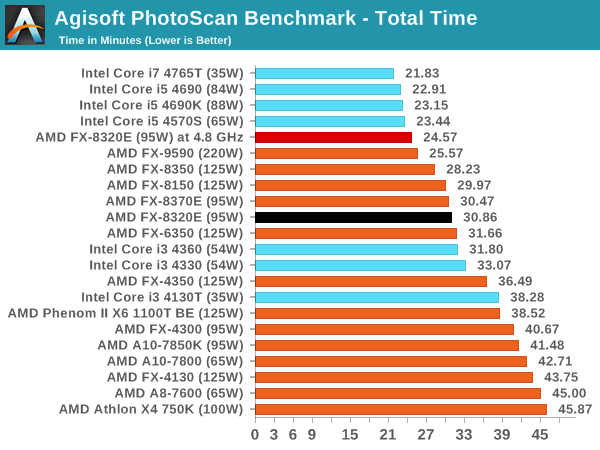
A highly parallel benchmark like Photoscan puts the FX CPUs ahead of our i3 results. When overclocked, it plays just behind the i5 results.
Cinebench R15
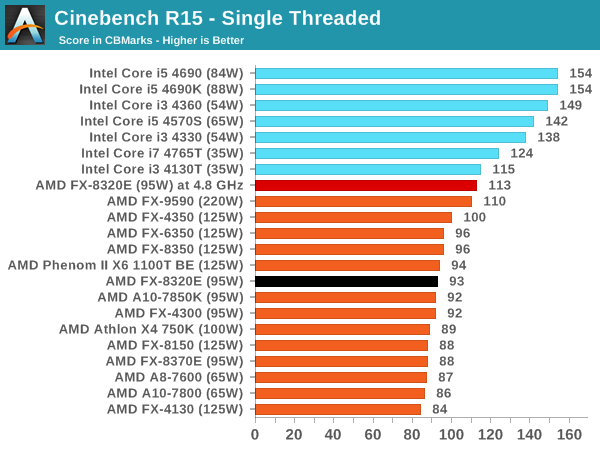
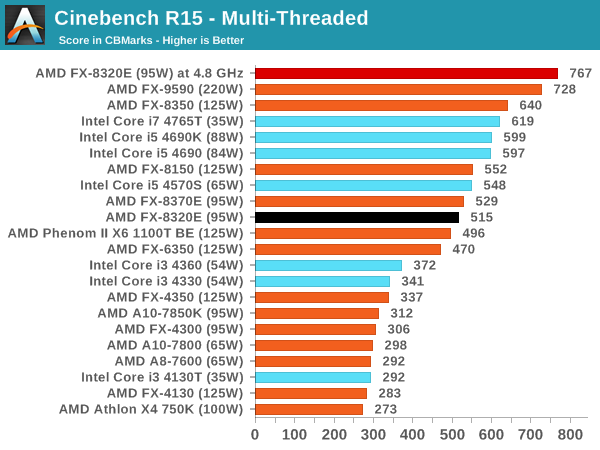
Professional Performance: Linux
Built around several freely available benchmarks for Linux, Linux-Bench is a project spearheaded by Patrick at ServeTheHome to streamline about a dozen of these tests in a single neat package run via a set of three commands using an Ubuntu 14.04 LiveCD. These tests include fluid dynamics used by NASA, ray-tracing, molecular modeling, and a scalable data structure server for web deployments. We run Linux-Bench and have chosen to report a select few of the tests that rely on CPU and DRAM speed.
C-Ray: link
C-Ray is a simple ray-tracing program that focuses almost exclusively on processor performance rather than DRAM access. The test in Linux-Bench renders a heavy complex scene offering a large scalable scenario.
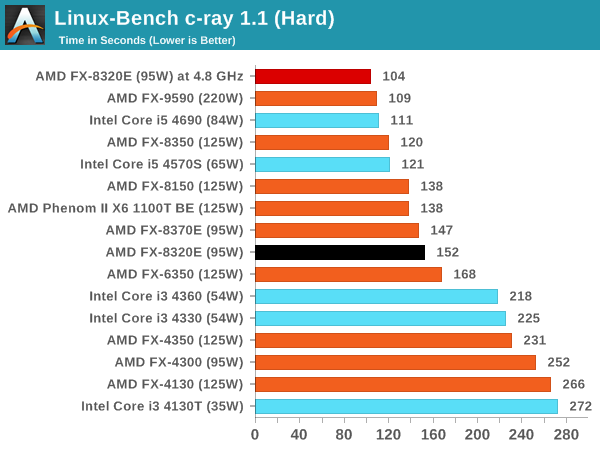
Ahead of the i3, behind the i5 until overclocked seems to be a good motto for this CPU.
NAMD, Scalable Molecular Dynamics: link
Developed by the Theoretical and Computational Biophysics Group at the University of Illinois at Urbana-Champaign, NAMD is a set of parallel molecular dynamics codes for extreme parallelization up to and beyond 200,000 cores. The reference paper detailing NAMD has over 4000 citations, and our testing runs a small simulation where the calculation steps per unit time is the output vector.
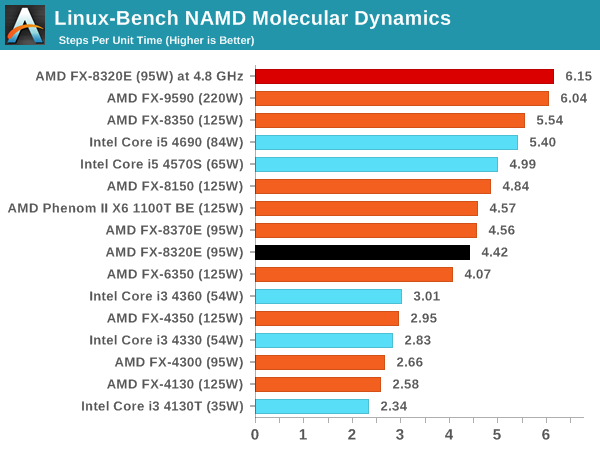
NPB, Fluid Dynamics: link
Aside from LINPACK, there are many other ways to benchmark supercomputers in terms of how effective they are for various types of mathematical processes. The NAS Parallel Benchmarks (NPB) are a set of small programs originally designed for NASA to test their supercomputers in terms of fluid dynamics simulations, useful for airflow reactions and design.
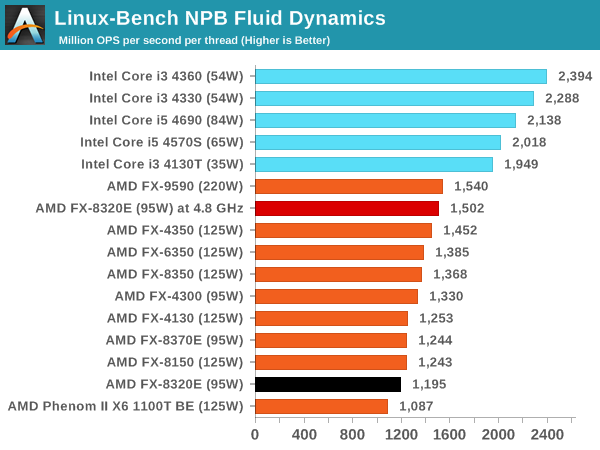
Redis: link
Many of the online applications rely on key-value caches and data structure servers to operate. Redis is an open-source, scalable web technology with a b developer base, but also relies heavily on memory bandwidth as well as CPU performance.
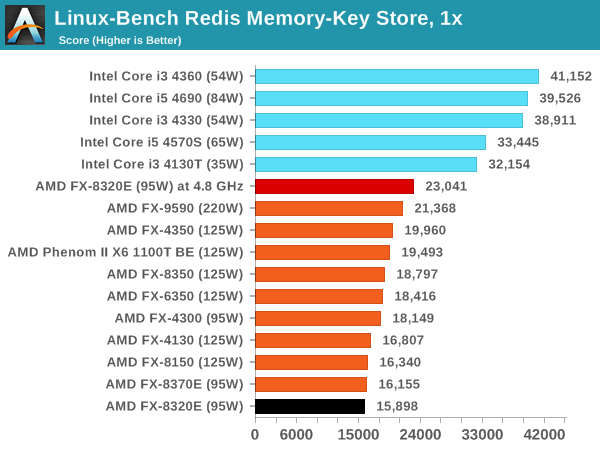
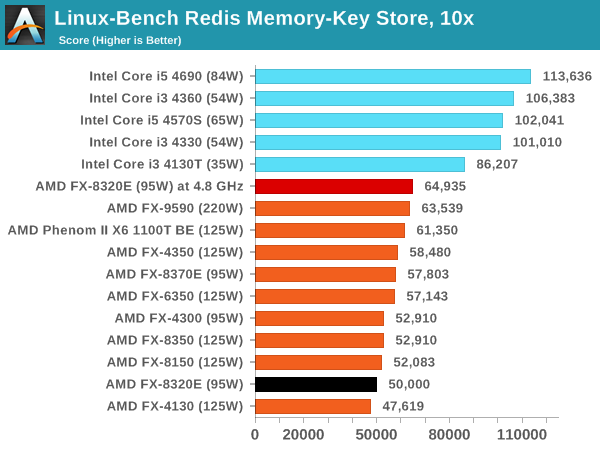
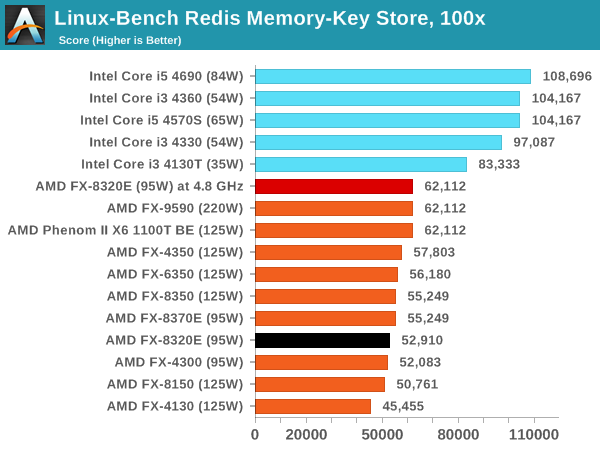
It would seem that one downside to the AMD FX line is the memory access limited scenarios, unless more cores can come into the equation. For redis, that is unfortunately not the case.










92 Comments
View All Comments
jabber - Friday, January 16, 2015 - link
And with the labour charges etc. all included you could well have just bought a job lot of new Dell Dimensions.Plus decent AM3 chips are tres expensive now.
phoenix_rizzen - Friday, January 16, 2015 - link
Actually, our hardware costs are decreasing slightly each year while the hardware it buys is increasing. Our current desktops are around $150 CDN including motherboard with Radeon graphics onboard, Athlon-II x4 CPU, 2 GB of RAM. We run diskless Linux, so no harddrive, no floppy drive, no optical drive; the only moving parts are the CPU, PSU, and case fans (and sometimes we even remove the case fan).Our original build with nVidia 6100 graphics onboard, 512 MB of RAM, and a Sempron CPU was over $200 CDN 7-odd years ago.
Buying the CPUs in bulk for upgrades was less than half the cost of a new system. Buying RAM upgrades was much less than half the cost of a new system. And a single tech working for a full day could upgrade an entire lab of 30 stations with some time to spare for testing ... for less than the cost of a single new system.
We've been doing this for just over 12 years now. We know which is less expensive for us, and it's not buying name brand computers with Intel CPUs and chipsets. Everytime we put a bid out for systems, the Intel systems are more expensive without being a whole lot more powerful, and they require discrete GPUs, whereas the AMD systems include graphics support on the motherboard (Intel 3D has improved over the years, but still doesn't hold a candle to nVidia or AMD).
ddriver - Wednesday, January 14, 2015 - link
Why would you go for an AMD build? I am not a big fan of Intel's past practices, and as much as I sympathize with AMD their products are simply way too weak, their performance per watt ratio is so low the lower hardware price doesn't really matter, you still end up paying more for it when you account for the electricity bills.Besides, for an office machine, a 5W ARM board costing 35$ suffices.
The only reason I can think of buying AMD is in case you want to burn some money to keep AMD afloat for the sake of not leaving intel without competition, not that AMD is much of a competitor anyway... More like a perpetually crippled "competitor" existing solely for the purpose of not running unopposed.
phoenix_rizzen - Thursday, January 15, 2015 - link
See my post just above yours (posted after yours in time).ddriver - Saturday, January 17, 2015 - link
So the people who benefit from AMD are those who don't have enough money, so they can end up spending more for less over time? Doesn't sound like a good deal...phoenix_rizzen - Monday, January 19, 2015 - link
And I guess black is white and down is up in your world?Jinx50 - Sunday, January 25, 2015 - link
Ironically in contrast to all the misinformation spewed "above and below" I still play Crysis 3 on ultra with a overclocked 1090T @ 3.8GHz and a HD 6970.I'm still waiting for the unplayable game to arrive "to give me a reason to upgrade" meanwhile I have to ask, how many Intel chips and boards have you all burned cash on in the last 5 years?
I'm not hating on Intel just stating facts "in my instance in regards of the bang for the buck factor", and I will probably snag an FX 8xxxx when this rig finally hits the medium settings wall.
AMD is not a processor for those who don't have the money "on the contrary". It's the processor for those who want to KEEP THEIR MONEY. ROFL I could dump money on an Intel but do I want to ride that roller coaster NOPE..
Oxford Guy - Thursday, April 2, 2015 - link
The minimum frame rates in that Bioshock Infinite chart are worrisome.stefstef - Wednesday, January 21, 2015 - link
nope. intel just has the better processor portfolio. this is not because amd cpus are so bad, but intel has the advantage of a much lower production process (22nm instead of 32nm). they are technically ahead in every sector: design, process and manufacturing. nonetheless amd makes sense as intel charges for the premium quite some good money. the usual jobs might be done by a amd as well as an intel.TheinsanegamerN - Wednesday, January 14, 2015 - link
I wouldnt go so far as to say that AMD wont give you a good experience. I traded, on a bet, my motherboard and cpu with my other pc gaming friend, and went from an i5 3570k to aq fx 6300. know how much of a difference there is? nothing. both get 60fps in everything at 1200p with my 770. i will say, if i have multiple game servers running in the background, the fx does not slow down nearly as much as the i5 ever did, even though hypothetically the i5 was more powerful, it couldnt multitask as well.and with the new consoles both coming with 8 core cpus, i think AMD chips will still work well, at least for the forseeable future.